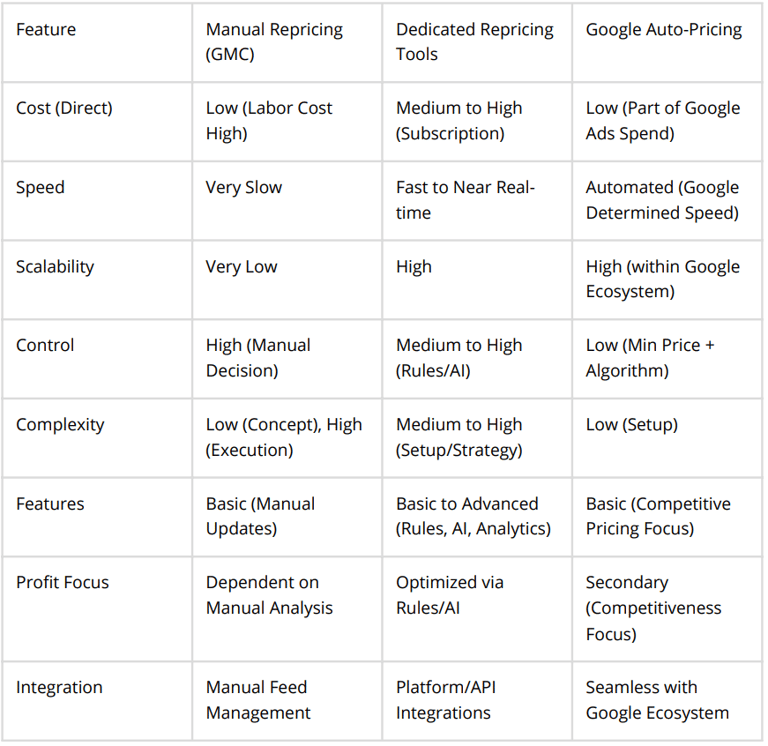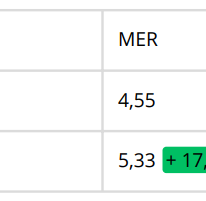Evaluating Ecommerce Repricing Strategies for Enhanced Retail Performance
Maximize your e-commerce profits with a smart pricing strategy. This article compares manual, Google, and automated repricing solutions, showing you how to choose the best method for your business.
Marcello Riccio
8/30/20254 min read


Introduction
In the rapidly evolving world of e-commerce, retailers are under constant pressure to optimize their performance to stay competitive. The digital age has transformed pricing from a static element into a dynamic, data-driven strategy. Static pricing, with its fixed prices over long periods, is no longer sufficient in a market where conditions can change rapidly. This has led to the adoption of dynamic pricing, also known as automated repricing, where prices are adjusted automatically based on real-time market dynamics. This approach leverages algorithms and market intelligence to adjust prices according to factors such as competitor pricing, demand changes, inventory levels, and customer behavior. Dynamic repricing is not just about matching competitors' prices. Retailers aim to achieve multiple strategic goals, including maximizing profits, staying competitive, increasing sales volume and market share, optimizing inventory, and enhancing customer satisfaction. However, excessive price fluctuations need careful management to avoid customer confusion or dissatisfaction.
The Challenge
E-commerce retailers operate in a highly competitive environment where prices are visible and constantly adjusted by competitors, often using automated tools. This makes it challenging for businesses using manual processes to keep up. As price remains a dominant factor for consumers, developing a competitive pricing strategy is crucial.
Exploring Repricing Solutions
To effectively implement a scalable repricing strategy, three approaches are evaluated: manual repricing using Google Merchant Center data, dedicated repricing software tools, and Google's native automatic pricing feature. Each method offers unique processes, advantages, and disadvantages.
Manual Repricing via Google Merchant Center (GMC)
This method involves using data from Google Merchant Center to manually adjust prices.
Pros:
Cost: No direct software cost, though labor-intensive.
Control: Retains complete manual control for nuanced adjustments.
Simplicity: Straightforward concept of updating prices based on competitor data.
Cons:
Scalability: Difficult to manage as inventory grows.
Speed: Slow reaction time to competitor price changes.
Labor Intensity: Demands significant human resources.
Human Error: Prone to errors in data entry and analysis.
Data Consistency: Challenging to maintain across channels.
Limited Scope: Difficult to incorporate multiple variables.
Dedicated Repricing Software/Tools
These tools automate and optimize pricing using user-defined parameters or algorithms.
Functionality:
Automation: Continuously monitors prices and adjusts automatically.
Rule-Based and Algorithmic Repricing: Can set specific rules or use AI for optimal pricing.
Competitor Tracking & Analysis: Provides insights into market trends.
Integration: Offers seamless data flow with platforms like Shopify.
Pros:
Automation & Efficiency: Reduces manual effort and operates 24/7.
Speed & Responsiveness: Quick reaction to market changes.
Scalability: Handles large catalogs and complex strategies.
Reduced Human Error: Minimizes manual data entry errors.
Advanced Features: Offers sophisticated strategies and analytics.
Profit Optimization Focus: Designed to maximize profit margins.
Cons:
Cost: Subscription-based, requiring ROI justification.
Complexity & Learning Curve: Requires setup and technical expertise.
Potential for Price Wars: Aggressive rules can trigger price wars.
Over-reliance/Loss of Control: Can lead to suboptimal pricing without oversight.
Integration Challenges: May face technical hurdles in data flow.
Data Accuracy Dependency: Relies on accurate data for effectiveness.
Google Automatic Pricing (g:auto_pricing_min_price)
Google's feature helps maintain competitive pricing within its ecosystem.
Functionality:
Integration: Seamlessly integrates with Google Merchant Center.
Simplicity: Simple implementation by adding an attribute to the product feed.
Leverages Google Data: Utilizes Google's market data for pricing.
Cost: Part of Google Merchant Center functionality.
Pros:
Integration: Simple setup for retailers using Google platforms.
Simplicity: Easy to implement with minimal technical setup.
Leverages Google Data: Uses Google's sophisticated algorithms.
Cons:
Limited Control: Less granular control over pricing logic.
"Black Box" Algorithm: Limited visibility into pricing decisions.
Google Ecosystem Focus: Primarily geared towards Google properties.
Minimum Price Focus: Less aggressive in raising prices when competition is low.
Potential Conflict: Requires careful configuration with other tools.
The choice among these methods involves balancing control, automation, cost, and complexity. Manual repricing offers control but lacks efficiency, while Google's solution is simple but less strategic. Dedicated tools provide automation and flexibility at a cost. Success depends on the retailer's specific needs and strategic priorities.
Comparative Analysis of Repricing Methods
The following table summarizes key differences:




Impact on Key E-commerce Metrics
Dynamic repricing significantly affects performance indicators:
Sales Volume & Revenue: Repricing can dramatically boost sales, as seen with a 76% increase. Studies show an average 145% sales increase with automation.
Profit Margins: While sales increase, aggressive repricing can erode margins. Sophisticated strategies aim to protect or maximize profits.
Conversion Rates: Competitive pricing improves conversion rates, especially in Google Shopping Ads.
Buy Box / Search Visibility: Repricing is crucial for winning the Amazon Buy Box and improving visibility.
Market Share: Competitive pricing attracts more customers, increasing market share.
Customer Perception: Well-managed pricing enhances satisfaction, but transparency is key to avoiding negative perceptions.
Return on Investment (ROI): ROI is driven by increased revenue, protected margins, and operational efficiencies.
Results & Impact Analysis
This case study focuses on an e-commerce retailer who implemented a repricing strategy based on competitor prices, leading to a 76% week-on-week increase in sales. While this initial success is impressive, it raises questions about the impact on profitability, as indicated by changes in key metrics such as MER (Marketing Efficiency Ratio) and POAS (Profit on Ad Spend) across different weeks.
This is where the WOW effect comes in. Both MER and POAS up despite falling prices. This happens because Conversion rate increased.
Conclusion & Recommendations
Dynamic repricing is essential for e-commerce retailers in competitive markets. The initial 76% sales increase highlights the potential, but sustainable success requires strategic management.
Choosing the Right Approach
Assess Your Needs: Evaluate your business scale, market competitiveness, and team capabilities.
Start Simple (Google Auto-Pricing): Suitable for those focused on Google Shopping.
Invest in Tools (Dedicated Software): Necessary for competitive markets with large inventories.
Avoid Manual Repricing at Scale: Unsustainable for growth-focused businesses.
General Implementation Recommendations
Strategy Before Tactics: Define clear goals for repricing efforts.
Prioritize Data Accuracy: Ensure accurate data for effective repricing.
Protect Profitability: Implement minimum price floors to avoid unprofitable wars.
Monitor and Adapt: Continuously monitor performance and adjust strategies.
Balance Automation with Oversight: Use automation for efficiency but maintain human oversight.
In conclusion, dynamic repricing is a critical component of e-commerce strategy. While initial sales increases are encouraging, long-term success requires choosing the right approach and continuously optimizing the strategy to align with business goals.


Growth hacker ecommerce
Growing ecommerce through innovative digital strategies.
Marcello Riccio
© 2025. All rights reserved.


